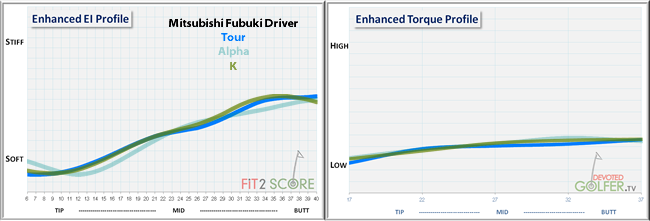MITSUBISHI BASSARA ULTRALITE
By Russ Ryden, A Golf Digest America’s 100 Best Clubfitter
Fit2Score, Dallas Fort Worth, Texas
Mitsubishi Bassara UltraLite Series W
![]()
The lightweight Bassara Wyvren was introduced in 2011. Like the Griffin, it has elastic titanium fiber reinforcing the tip. It has a unique color scheme, resembling the Griffin. It is appropriately red, Bassara W-Series, as it is now called, profile is the same as the ‘ilima. Look for a high launch with low spin from this shaft. The golf shaft is now referred to as the Bassara Series W. The shaft to shaft consistency and smoothness of the profile is among the best I have measured. The overall torque of the Bassara W-Series ranges from 6.1 in the 43L to 4.3 in the 53TS. This is consistent with the general torque range of the Mitsubishi Rayon Family of shafts if one compares the torque of the 53 Bassara W-Series with the 60g R’s of the other products. Three and four degree TIP torques are outstanding in this weight range of shafts.

Mitsubishi Bassara UltraLite Series G
![]()
The lightweight Bassara Griffin is unique. Introduced in 2010, it has elastic titanium fiber reinforcing the tip. Mitsubishi is unique in the shaft business; they make all the critical shaft raw materials, monomer, acrylic fiber, carbon fiber, resin and prepreg. When they decide to make a unique product, they have few restrictions. The Griffin is one such product. In the hands of a slow swinging, yet skilled golfer this shaft delivers the head consistently. Originally branded as the Griffin, it is now referred to as the Bassara G. It is the higher launching, higher spinning design of the 2012 Mitsubishi ultra lightweight driver shafts The overall torque of the G -Series ranges from 5.6 in the 43L to 4.0 in the 53TS. This is consistent with the general torque range of the Mitsubishi Rayon Family of shafts if one compares the torque of the 53 Bassara G-Series with the 60g R’s of the other products. Three and four degree tip torques are outstanding in this weight range of shafts. In light weight shafts, higher torques are needed to create feeling in the hands of the golfer.

Mitsubishi Bassara UltraLite Falcon
![]() The lightweight Bassara Falcon has been in the lineup for a long time. Formerly known simply as the Bassara UltraLite, its EI profile is similar to the Diamana Blue Board. It was a great feeling shaft for lower swing speed players that benefit from a light weight golf shaft. The elastic titanium fiber used in the tips of the Bassara W and G series created a new generation of lightweight designs. The Bassara Falcon was discontinued in 2012. I am fitting the few I have left at a close out price. It is a great senior shaft. The are consistent from weight to weight and flex to flex. The torque ranges from 5.1 in the 43L to 4.1 in the 53S. The radial profiles are excellent; the shaft can be used in any orientation. The profile will be brought back in 2013 in a stock club.
The lightweight Bassara Falcon has been in the lineup for a long time. Formerly known simply as the Bassara UltraLite, its EI profile is similar to the Diamana Blue Board. It was a great feeling shaft for lower swing speed players that benefit from a light weight golf shaft. The elastic titanium fiber used in the tips of the Bassara W and G series created a new generation of lightweight designs. The Bassara Falcon was discontinued in 2012. I am fitting the few I have left at a close out price. It is a great senior shaft. The are consistent from weight to weight and flex to flex. The torque ranges from 5.1 in the 43L to 4.1 in the 53S. The radial profiles are excellent; the shaft can be used in any orientation. The profile will be brought back in 2013 in a stock club.

Mitsubishi Bassara UltraLite Hawk
![]()
The lightweight Bassara Hawk was a Diamana White Board on a diet. I never cease to be amazed at the range of players that simply crush balls with this shaft. The raw shafts weigh between 46 – 55 grams. For a skilled swinger that does not have the strength to load a White Board, this is a great alternative. Like all Mitsubishi Rayon golf shafts, the profiles of the Basara Hawk are consistent from weight to weight and flex to flex. The torque ranges from 5.1 in the 43L to4.1 in the 53S. The profiles are consistent from weight to weight and flex to flex. The radial profiles are excellent; the shaft can be used in any orientation. Discontinued in 2012 a similar profile is found in the JavlnFX Y.




